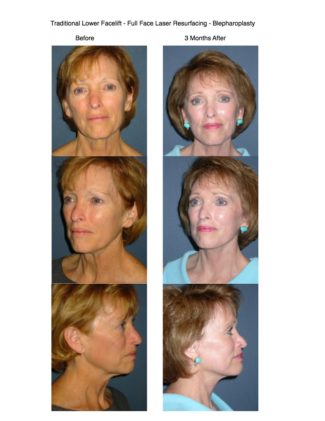
 A facelift is an operation that elevates and redrapes the facial skin and muscles to eliminate laxity and sagging. The operation can be designed to correct problems in the neck, under the jaw, under the chin and in the cheeks. It can also be applied to the skin in the temporal regions and the forehead.
A facelift is an operation that elevates and redrapes the facial skin and muscles to eliminate laxity and sagging. The operation can be designed to correct problems in the neck, under the jaw, under the chin and in the cheeks. It can also be applied to the skin in the temporal regions and the forehead.
As individuals age, there is a change in the skin just as there are changes in all other parts of the body. Fatty tissue tends to decrease in volume and in density causing the skin to fit more loosely. There are also changes in the bones of the face which combine with changes in muscular action and gravity leading to more prominent skin folds. These changes are greatest under the chin, in the upper neck and at the skin folds near the corner of the mouth. Contour imperfections of the nose may also become more noticeable as the overlying soft tissue decreases in volume.
The traditional facelift operation is designed to improve these facial conditions.
A general anesthetic is usually selected although the surgery can be performed under local anesthesia with sedation. The operation involves lifting and removing the excess skin. However, an equally important part is the tightening and support of the underlying tissues and muscle, which helps to give a longer lasting result.
 Another important aspect of the operation is the removal of the excess fatty tissue found in the neck and jowls of many patients. This is usually removed with micro-liposuction surgery which has become a standard part of the modern facelift operation. For additional details about liposuction surgery, please refer to that chapter in this book.
Another important aspect of the operation is the removal of the excess fatty tissue found in the neck and jowls of many patients. This is usually removed with micro-liposuction surgery which has become a standard part of the modern facelift operation. For additional details about liposuction surgery, please refer to that chapter in this book.
The incisio ns for a facelift will vary depending on the exact problem to be corrected, but usually involve an incision within the temple and one wrapping around the ear and ending in the hair behind the ear. We have developed a “hair sparing” technique in which we advance tissue rather than excise it in hair bearing areas. The major pull of the operation is on deeper structures rather than skin. This means that little or no hair is removed during surgery. In all cases, the incisions are placed in areas where they will be well hidden. In exposed areas, very fine absorbable suture is used which is nearly invisible from the start. Consideration will be given to whether the patient is male or female, hair pattern, areas that need most correction, etc. This is reviewed individually with each patient.
ns for a facelift will vary depending on the exact problem to be corrected, but usually involve an incision within the temple and one wrapping around the ear and ending in the hair behind the ear. We have developed a “hair sparing” technique in which we advance tissue rather than excise it in hair bearing areas. The major pull of the operation is on deeper structures rather than skin. This means that little or no hair is removed during surgery. In all cases, the incisions are placed in areas where they will be well hidden. In exposed areas, very fine absorbable suture is used which is nearly invisible from the start. Consideration will be given to whether the patient is male or female, hair pattern, areas that need most correction, etc. This is reviewed individually with each patient.
Very Fine Skin Wrinkles
Surgical treatment of facial sagging will result in limited benefit where very fine skin wrinkles are the most prominent deformity. There are other means to achieve improvement of these surface conditions such as laser resurfacing. In many cases, regional surface treatment can be combined with facelifting. We have found that by combining laser resurfacing with a facelift, the benefits of both are enhanced. The lifting corrects the sag while the resurfacing helps to minimize fine lines and imperfections. Since facelifting is now carried out in a deeper plane
than in past years, it has been shown safe to combine skin resurfacing with the deeper lifting. Surface surgery, including laser, is covered in a separate chapter in this book.
There has been a grea t increase in the popularity of the facelift operation as a result of the improvements in techniques. Patients are now seeking surgery at an earlier age. There is no upper and lower age limit for the operation. While correction is perfectly possible in the late sixties or seventies, overstretched muscles with lack of tone become more difficult to repair, and the result, while still good, may not be as long-lasting. When surgery is carried out at a younger age, the results may well last longer, although the initial change will not be as striking. Indeed, patients in their thirties and eighties have facelifts with very satisfactory results.
t increase in the popularity of the facelift operation as a result of the improvements in techniques. Patients are now seeking surgery at an earlier age. There is no upper and lower age limit for the operation. While correction is perfectly possible in the late sixties or seventies, overstretched muscles with lack of tone become more difficult to repair, and the result, while still good, may not be as long-lasting. When surgery is carried out at a younger age, the results may well last longer, although the initial change will not be as striking. Indeed, patients in their thirties and eighties have facelifts with very satisfactory results.
FOREHEAD AND BROW LIFT
The standard facelift is most effective in improving the mid and lower face, as well as the neck. Additional procedures that can be done either with the standard facelift, or as separate operations, help to improve the
forehead, temple and brow regions. These are discussed in the chapters on Extended Subperiosteal Coronal Lift and Endoscopic Forehead Lift.
THE “TUCK”
The results of a facelift can be lasting. Although the procedure does not stop the aging process, it certainly slows down the clock. An individual who has a facelift will probably always look younger than he or she would have, had the operation not been performed. However patients continue to age after surgery and it is unlikely we will find a way to stop this in the near future. But there is a solution, and that is to consider a “secondary tuck” a year or so following the facelift.
The secondary tuck is a much less extensive procedure that, when carried out a year or so after the initial operation, appears to erase the passage of time and produce an even more lasting effect. This is because the original facelift operation results in a network of thin scar tissue beneath the skin. This scar tissue is “stiffer” than normal subcutaneous tissue and holds better when tightened through surgery. This has become very popular among our patients who have had a facelift.
The operation is performed through some of the same incisions used for the original operation, and so, there is no new scarring. The recovery from this secondary operation is minimal with most patients resuming normal activity within a day or so. Because there is much less dissection involved, this surgery can easily be carried out under local or light general anesthesia.
Of equal importance is the fact that secondary lifts carried out after a complete facelift are much less expensive than the original surgery, and to encourage our patients to consider this option, we offer a special price if done within two years of the original facelift. For many of our patients, it is considered maintenance treatment and repeated on a regular basis.
SECONDARY FACELIFT
For patients who have had a major facelift several years ago, an intermediate procedure may be ideal. The secondary facelift involves incisions similar to the initial operation but the deep dissection may differ depending on findings at surgery. Like the primary or “traditional facelift,” general anesthesia is usually chosen. Recovery is similar to the full lift, but may be a few days shorter.
RISKS AND COMPLICATIONS
Complications are relatively infrequent in a well-performed facelift. There can be some blood collection under the skin – a condition called hematoma. This is much more common in men and especially in smokers. This often can be treated during the follow-up office examination and will not affect the overall results. Larger collections may require earlier and more vigorous treatment and could possibly require reopening of the surgical incision to remove the clotted blood.
Although post operative bleeding usually will not prevent a satisfactory result from surgery, it can significantly delay complete recovery. For that reason, patients must understand that recovery times that are discussed are estimates that can vary considerably.
There may be some temporary lag in the normal motion of the facial muscles. Generally this is related to the local anesthetic that is used to supplement the general anesthetic. In rare cases, this weakness could be longer lasting and perhaps even permanent.
Scarring is a natural sequela of any incision. Some people heal with better scars than others do. Because of their placement, facelift scars are hardly noticeable. If they are a problem, they can often be improved by injections of a scar softener or a minor secondary scar revision. Scars always look worse shortly after surgery, and it takes a full year for them to fade to their best appearance.
While infection is rare after facelift surgery, as with all operations, it is possible, and while usually readily amenable to antibiotic treatment, it can, on occasion, be serious or difficult to treat.
RECOVERY FROM THE FACELIFT OPERATION
Dr. Tobin generally does not use dressings after facelift surgery. We find that patients are more comfortable without them. Additionally, if problems develop, dressings may hide them and make them more difficult to diagnose. Patients wear an elastic neck strap part time for a few weeks after surgery. Initially there may be a feeling of numbness and tension in the operative area. This usually disappears within the first few weeks but may last longer. Swelling and bruising vary but are usually gone within two weeks or so. Patients are active within a few days of surgery. Often there is a sense of tightness that can last for several weeks or even months. Excessive turning of the neck is discouraged during this time. Make-up can be applied within a couple of days of surgery.
It must be recognized that marked degrees of skin laxity may not be entirely correctable with one operation. Some recurrent sagging can take place even after the first few months. Minor secondary procedures might therefore be desirable to achieve maximum benefit.

